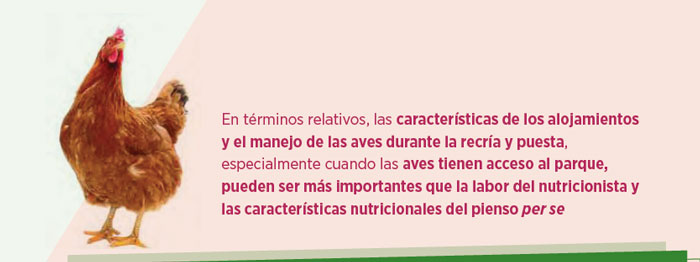Animal Nutrition
Nutrition management of layers in floor operations
To read more content about aviNews 2019 ENG
Animal Nutrition
To read more content about aviNews 2019 ENG
Content available at:
Español (Spanish)
The percentage of floor – aviaries and access to outdoors – operations has increased considerably in both the EU-28 and globally in recent years. Given the objectives of current legislation, consumer preferences and the commercial pressure of supermarket chains, this trend can be expected to continue in the future.
Floor laying does not modify the production objectives in terms of productivity and egg quality but affects the behavior of the birds and the uniformity of the flock, which in turn complicates the feeding program.
From a nutritional point of view, floor egg production differs from cage production in six fundamental ways:

The farmer’s work could have a greater impact on the productivity of the flock than the nutritionist’s work.
A serious but frequent problem is the excessive density of birds, having possible access to “winter” parks, but due to climatic or other reasons, are kept inside the building. Under these conditions, the work of the nutritionist is complex and ineffective.
Birds have a greater freedom of movement. Therefore, their energy needs increase, especially in the case of aviaries and production with access to parks. Protein needs, however, do not vary since amino acids are largely used for the production of egg mass. Therefore, the percentage of crude protein (CP) –and Amino Acids (AA)– and macro-minerals in the feed could be reduced. Bird handling is complicated, which often causes flock uniformity problems. A lack of uniformity gives rise to birds with variable consumption, which forces the nutritionist to increase safety margins and production costs.
Birds eat to meet their energy needs, and therefore it is expected that laying hens will consume around 5-10% more feed – depending on temperature, feather formation and physical activity – than their caged counterparts. Since the size of the egg is not key and the feed consumption is higher, it seems advisable to reduce the level of Met and the rest of the essential AA by at least 8-10%.
For this type of production, the genetics supply companies recommend feeds with a nutritional composition similar to those of conventional cage layers – Lohmann, 2016; Hy-Line, 2016. A possible explanation for high CP recommendations in floor-mounted birds would be due to the higher incidence of problems with pecking and cannibalism in flocks with limited space available, fed low CP feeds. In addition, excess CP allows for an increased margin of safety and improved flock uniformity.